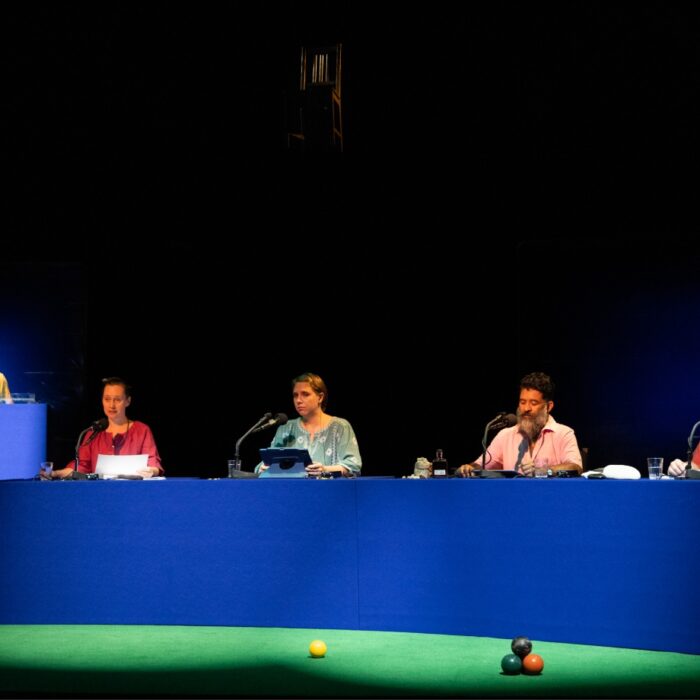
Händel Festspiele Halle 2025 Review: Clori, Tirsi e Fileno
Production Turns Baroque Pastoral Into a Psychological Close-up
By Mengguang Huang(Photo: Benjamin Elsholz)
In the Goethe-Theater of Bad Lauchstädt—Germany’s only fully preserved Goethe-era theater—Handel’s “Clori, Tirsi e Fileno” received a rare and refreshingly focused staging. Composed around 1707 for unknown purpose, this pastoral cantata, though small in scale, hints at operatic intensity. In this performance by three exceptional young singers under Michael Hofstetter, its elegant construction emerged as both theatrically compelling and musically refined.
The work stages a romantic triangle in which the beautiful shepherdess, Clori, toys with the affections of two young men—Tirsi and Fileno—only to lose them both when her fickleness comes to light. What begins as light-hearted pastoral flirtation gradually unravels into a subtle portrayal of jealousy, longing, and self-deception. Though nominally a “cantata,” the piece unfolds with genuine theatrical momentum and a keen dramatic arc.
Director-choreographer Alberto Pagani emphasized these psychological stakes with clarity and restraint. Three singers and three dancers shared the stage throughout, beginning with a stylized, wave-like entrance to the overture. The interaction between them established a visual grammar that continued across the show. The dancers became emotional mirrors, physical echoes of inner states, or—at some moments during the narrative—silent companions whose presence offered support when a character appeared emotionally vulnerable. Their bodies became emotional architecture: a shoulder to lean on, a space to be held.
Soprano Chelsea Zurflüh, as Clori, was a commanding presence from the outset. Physically and vocally, she crafted a vividly sensual and deliberately elusive figure—a coquettish “little cat,” playful yet always in control. Her tone was focused and luminous, with striking projection and precision. In “Barbaro, tu non credi,” she revealed the full range of Clori’s emotional arsenal: from teasing flirtation to self-pity, from feigned detachment to sudden vulnerability. Her Clori was calculating in the most seductive sense—one step ahead, always playing with emotional texture.
Nicolò Balducci, as Tirsi, was initially less settled—his opening aria felt slow and emotionally distant—but in the progress he gained momentum and expressive clarity. His interpretation of “Tra le fere la fera più cruda” showcased agile coloratura and a tightly coiled intensity, matched by responsive playing from the orchestra. He embodied a jealous suitor teetering between rage and resignation, a characterization both theatrically effective and musically satisfying.
Constantin Zimmermann brought warmth and nobility to the role of Fileno. His countertenor voice was flexible, and though some breath control wavered in the later scenes, he sustained a sense of introspective grace throughout. In “Come la rondinella,” his voice floated above a gossamer continuo line, projecting a gentle strength that made Fileno’s quiet dignity stand out amid the surrounding tension.
The Thüringen-Gotha-Eisenach Philharmonic Baroque initially delivered the French-style dotted-rhythm overture with energy verging on forceful, especially as string intonation briefly faltered. But balance was quickly restored, and as the drama unfolded, Hofstetter and his ensemble adopted a more nuanced, chamber-like approach. Particularly commendable were the two recorder players, whose graceful phrasing added warmth and sparkle. An extended solo lute interlude and later violin outbursts introduced welcome moments of improvisatory flair. The continuo section grew increasingly characterful, functioning not merely as harmonic support but as subtle commentary on the emotional turns of the plot.
Visually, the production leaned into elegant simplicity. A simple stylized Baroque landscape works as backdrop, with changes in lighting—from warm golden tones to cooler blues—marking shifts in mood. This painterly restraint was echoed in Stephan Bolz’s costume design: period-style clothings made in rustic fabrics and spring-like hues, visually anchoring the characters in a world that balanced artifice and immediacy. Each figure was distinct, yet harmonized within the palette—another expression of their entangled fates.
If this performance succeeded in lifting “Clori, Tirsi e Fileno” beyond its chamber origins, it was thanks to a coherent understanding of its hybrid identity: not quite opera, but something charged with potential energy. The staging neither exaggerated nor embellished; instead, it distilled. In doing so, it revealed what is perhaps most surprising about the twenty-two-year-old Handel: his uncanny grasp of how emotional complexity can unfold within compact forms. With elegance and bite, this production turned a small, pastoral triangle into a finely tuned study in the contradictions of desire.



